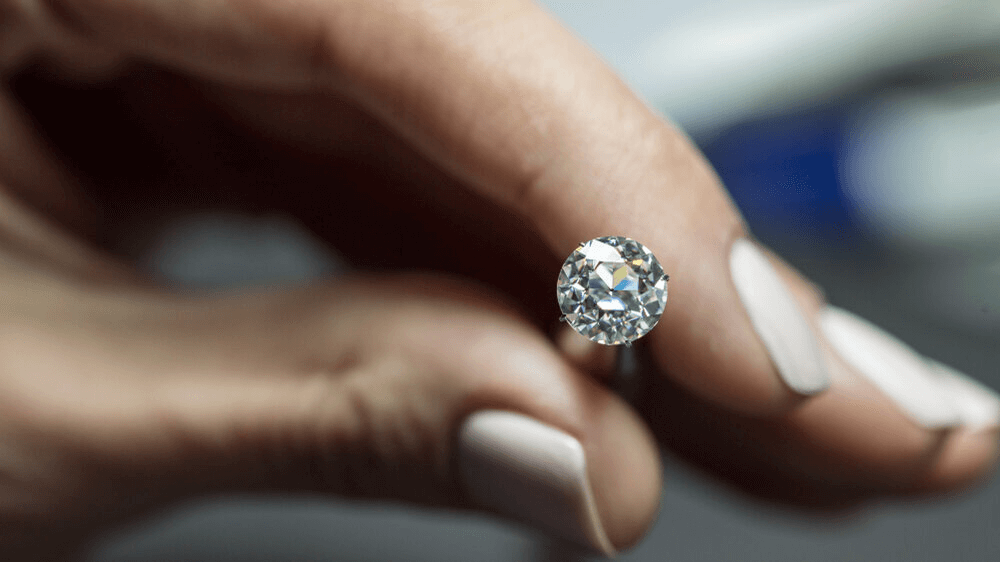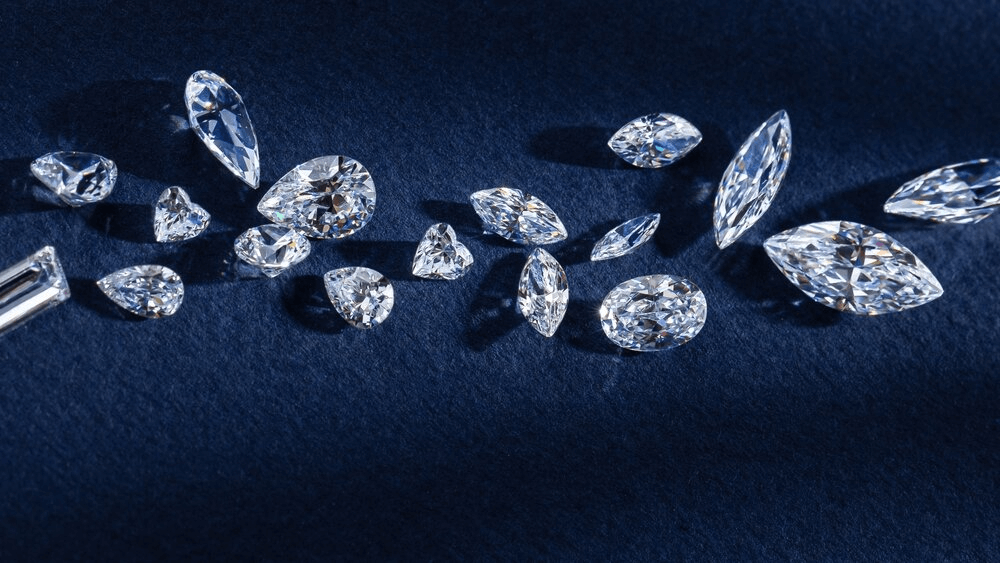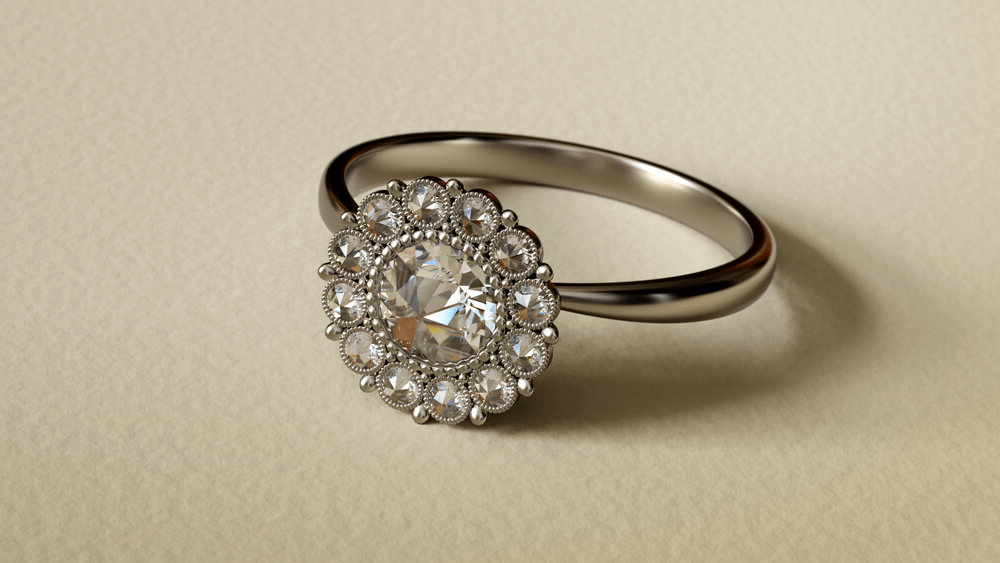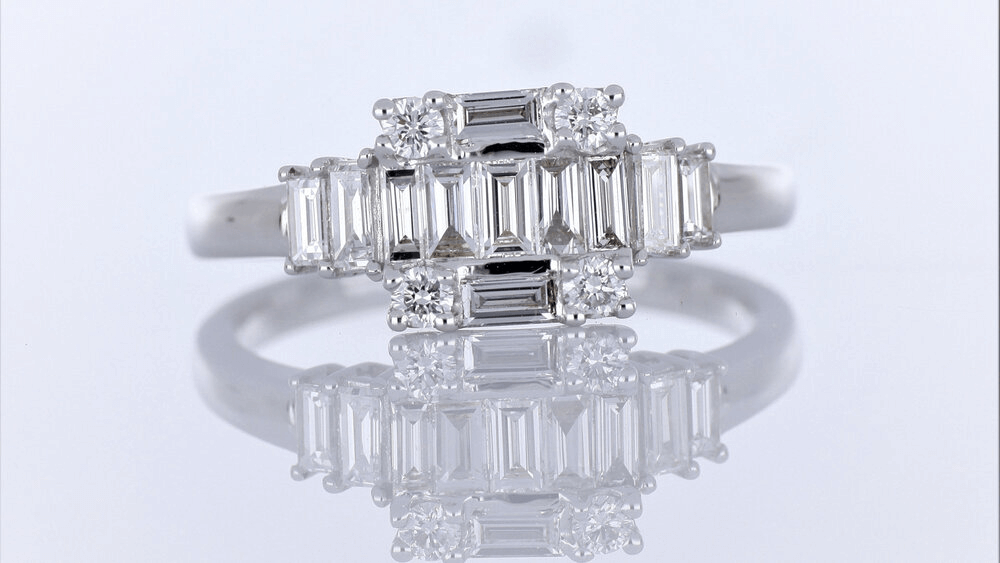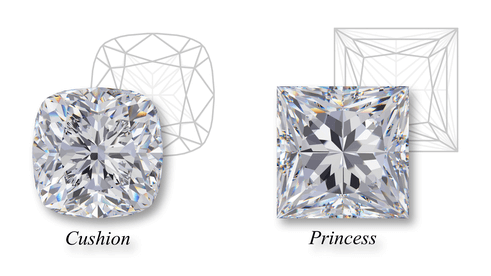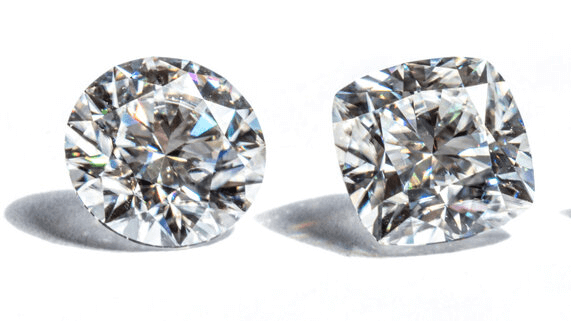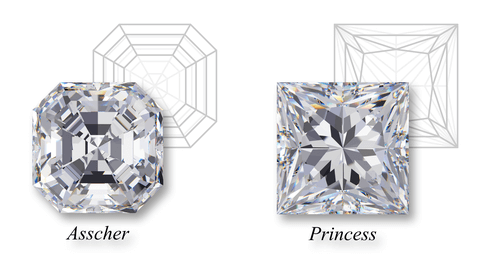Elongated Cushion Cuts: Best Settings to Complement Them

By Gary A.

Edited by Olivia H.
Published Mar 17, 2022
Edited on Dec 17, 2024
Elongated cushion cut diamonds offer a timeless elegance, combining the classic softness of the cushion cut with a modern, elongated shape that creates a striking and unique appearance for engagement rings.

- 6 Quick Tips for Buying an Elongated Cushion Cut Diamond Engagement Ring
- Introduction
- What is an Elongated Cushion Diamond?
- The Ideal Ratios for Elongated Cushion Cut Diamonds
- Square vs Elongated Diamonds: A Style Comparison
- Cost Considerations: Are Elongated Cushion Cut Diamonds More Expensive?
- Elongated Cushion Cut Engagement Ring Ideas
- Our Expert Take
- 10 FAQs
Before we dive deeper into the specifics, here are some practical tips to help guide your decision-making process:
6 Quick Tips for Buying an Elongated Cushion Cut Diamond Engagement Ring
When purchasing an elongated cushion cut diamond engagement ring, there are several key factors to consider to ensure you select a ring that meets your expectations in terms of beauty, quality, and value. Here are some essential tips to guide you through this process:
- Tip 1: Understanding the Ideal Ratios for Elongated Cushion Cuts: The length-to-width ratio significantly impacts the diamond’s appearance. Ideal ratios for elongated cushion cuts typically range from 1.15 to 1.20. A well-proportioned diamond will have balanced aesthetics and maximize its brilliance. Visual Appeal: Look for diamonds that maintain the cushion cut’s traditional appeal while offering an elongated shape. This balance will ensure the diamond’s elegance and unique charm.
- Tip 2: Examining the Cut Quality: The cut quality of an elongated cushion cut diamond determines its brilliance and fire. Ensure the diamond has a high-quality cut that enhances its sparkle and minimizes any potential bow-tie effect. Facet Patterns: Pay attention to the diamond’s facet pattern. Elongated cushion cuts should have a consistent and symmetrical pattern, enhancing the stone’s overall brilliance and beauty.
- Tip 3: Checking for Symmetry and Polish: A diamond with excellent symmetry will reflect light more effectively, resulting in greater sparkle. Ensure the elongated cushion cut has symmetrical sides and even proportions. Polish Quality: The polish of the diamond affects its shine. Look for diamonds with a very good to excellent polish grade to ensure the surface is smooth and reflects light optimally.
- Tip 4: Assessing Clarity and Color: While elongated cushion cuts can hide some inclusions, clarity is still crucial. Choose a diamond with a clarity grade that ensures no visible inclusions to the naked eye, typically VS2 or higher. Color Preferences: Decide on your preferred color grade. While some prefer the icy look of a colorless diamond, others might opt for a warmer hue. Elongated cushion cuts can exhibit color more noticeably, so select a grade that aligns with your preference.
- Tip 5: Evaluating the Ring Setting: Choose a setting that complements the elongated cushion cut. Popular options include solitaire, halo, and side-stone settings, which can enhance the diamond’s shape and size. Secure Mounting: Ensure the setting securely holds the diamond, especially considering the elongated shape. Look for settings that protect the corners and edges of the diamond, reducing the risk of chipping.
- Tip 6: Balancing Carat Weight with Other Factors: Decide on the right balance between carat weight and other quality factors. While a larger carat size is appealing, it shouldn’t compromise the diamond’s overall beauty and quality. Face-Up Appearance: Consider the diamond’s face-up size, as elongated cushion cuts can appear larger than their actual carat weight due to their shape. Choose a diamond that has an impressive presence while fitting within your budget.
Now that you’ve got these practical tips, use Jeweler AI below to find the perfect engagement ring that suits your style and budget:
Introduction
True to its name, the Cushion cut is one of the most luxurious and opulent of all the diamond shapes out there. It’s a shape that consistently proves incredibly popular for engagement rings, thanks to its plush shape and tremendous levels of fire and brilliance, and its versatility for ring design.
The most popular Cushion cut tends to follow square dimensions – or, in other words, in the majority of Cushion cut diamonds, each of the sides are the same length. The shape is softened, however, by four rounded corners, which keep the shape from resembling the much more angular Princess cut design. This is, after all, what gives the shape its name – its resemblance to a couch cushion. It’s a fascinating shape that somehow manages to make the hardest natural substance on earth appear plush and soft.
In some instances, however, you might find yourself looking at Cushion cut diamonds that feature rectangular proportions. These diamonds are known as Elongated Cushion cuts, and they offer a totally different aesthetic when used in jewelry – and totally different benefits, as well as some (potentially deal-breaking) disadvantages.
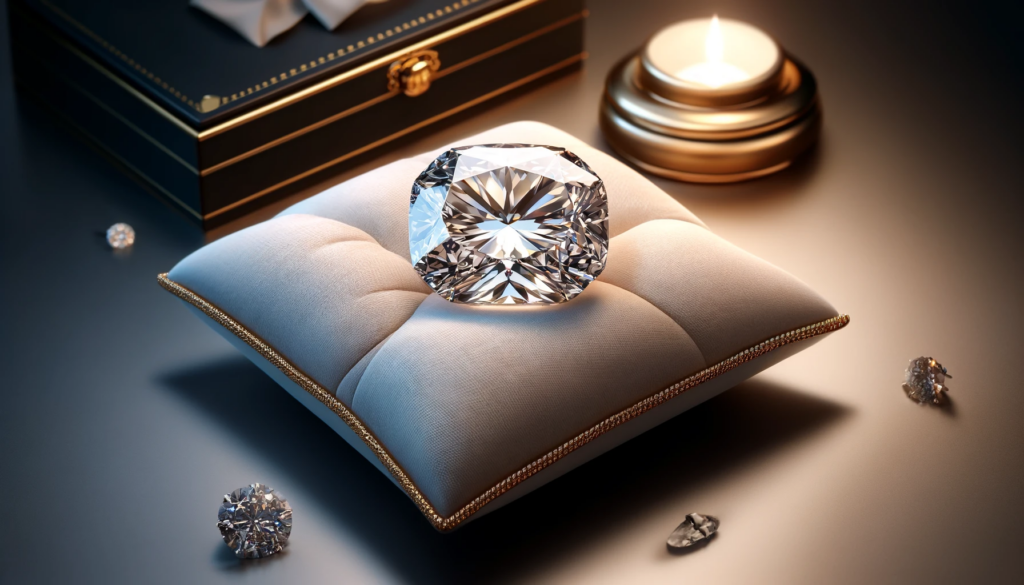
What is an Elongated Cushion Diamond?
We’ve written an in-depth guide to the Cushion cut already, and it’s a must-read for anyone thinking of putting this diamond in their engagement ring, but, owing to the popularity of the shape, we focused much more of our attention on the square Cushion, rather than the elongated (or rectangular) Cushion cut.
The elongated Cushion is very similar in terms of its facet pattern, which is why it is considered an alternative version of the Cushion shape, rather than a totally unique shape in and of itself.
When viewed face-up, the only clear difference between the two is length to width ratio. While the traditional, square Cushion obviously has a length to width ratio of 1:1 (or near enough to appear square), the elongated cushion can have a length to width ratio of 1.10 or more.
When viewed from other angles, it’s the difference is easily noticeable in the reduced depth of the elongated Cushion. More like an Emerald cut, a lot more weight is distributed across the upper portion of the diamond, rather than within the pavilion beneath.
The shape retains the Cushion cut’s distinctively round corners while creating a more noticeable difference between it and the Round Brilliant, which it can be confused with when seen from a distance.
There is no definitive ratio for an elongated Cushion. In some, the elongation is minor; in others, the stone looks particularly long and thin.
The Ideal Ratios for Elongated Cushion Cut Diamonds
As with any diamond shape, you’ll want to make sure that the diamond you pick out is accompanied by a GIA report, and that it has been given symmetry and polish grades of Excellent or Very Good.
But, beyond that, you’ll also want to pay close attention to the other details listed in the report. Even with good symmetry and polish, poor proportions can lead to a dull, lifeless, and generally unattractive diamond.
The GIA doesn’t offer a Cut grade for any shape but the Round Brilliant, but the industry does widely regard the following proportions to be ideal for the elongated Cushion cut.
Length to Width Ratio
Ideally, your elongated Cushion will feature a length to width ratio of 1.15 – 1.20. This would be considered Excellent.
A Very Good length to width ratio will be 1.10 – 1.14, or 1.21 – 1.30.
Table
An Excellent table percentage will fall between 60 – 65.9. Alternatively, a Very Good table percentage will fall between 58 – 59.9 or 66 – 69.9. If the table is too small, then the amount of light entering and leaving the diamond will be limited; too large and not enough light will be refracted into the crown.
Depth
When it comes to depth percentage, it’s best to look at diamonds that fall between 63 – 67.9 (Excellent), or either 58 – 62.9 or 68 – 69.9.
Girdle and Culet
As with any diamond shape, it’s best to focus on diamonds with no culet, or one graded Very Small. Any larger, and you will start to be able to see the culet through the table of your diamond.
The girdle should be graded Very Thin to Slightly Thick. If the girdle is too thin, the integrity of the diamond is at risk; too thick and you will be able to notice it.
Square vs Elongated Diamonds: A Style Comparison
If you’re already feeling drawn towards the Cushion cut, then learning about the existence of the slightly less popular elongated Cushion can be something of a curveball. Here are your burning questions about the differences between the two, answered.
Face-Up Appearance
Most elongated shapes, whether the Marquise, Oval, Pear or Emerald, appear larger than shapes with length to width ratios that are more even (or totally even).
One of the disadvantages to Cushion cut diamonds (square) is that they are one of the deeper cuts, which means that their face-up appearance (what you see when you’re looking down at the diamond, as you do when it’s set within a ring setting) is smaller than the face-up appearances of the diamonds we mentioned above.
For a lot of shoppers, finding an impressive, sizeable diamond is a priority, so other shapes tend to win out against the Cushion.
The elongated Cushion offers a convenient alternative – one that retains the unique essence of the Cushion, without losing too much of the diamond’s overall weight to the lower portion of the cut.
Then again, the Cushion’s deeper cut gives it one distinct advantage over other shapes…
Brilliance and Fire (Sparkle)
Since the elongated Cushion is a little shallower than the square, some of the shape’s characteristically vivid light performance is lost.
Square Cushion cuts are known for their fire – the vibrant, colored flashes of light that diamonds can create alongside those stark, white flashes of brilliance. While almost all diamond shapes produce plenty of fire, the unique proportions of the Cushion make it a particularly powerful source. It’s for this reason that a lot of shoppers overlook the square Cushion cut’s slightly smaller face-up appearance.
By elongating the Cushion cut’s design and allocating more weight to the upper portion of the diamond, some of that fire-producing potential is lost. The elongated Cushion cut remains a very sparkly and vibrant shape, but you will notice a difference in a side-by-side comparison between the square Cushion and the rectangular Cushion.
Impact on Finger Appearance
Elongated Cushions can be a little more flattering since the elongated shape can offer the illusion of length to the finger, and make it appear slimmer. This is why shapes like the Emerald and Oval often prove so popular, too.
This is another reason why the elongated shapes are so popular. While the Round Brilliant consistently comes out on top, the Oval is almost always close behind because, while similar in style, it offers a more flattering shape for the finger.
Cost Considerations: Are Elongated Cushion Cut Diamonds More Expensive?
Elongated Cushion cut diamonds tend to be priced comparably with square Cushion cut diamonds, or a little lower.
Remember that this will only hold water if other aspects of quality are the same. In two Cushion cut diamonds featuring the same clarity, color and cut grades, correct proportions (for their different ratios) and the same level of fluorescence – not to mention the same carat weights – you are unlikely to find any remarkable difference in price.
Elongated Cushions are less common, but they’re also not highly sought-after like some shapes, so sellers don’t attach a premium price to them.
Elongated Cushion Cut Engagement Ring Ideas
Liking the look of an elongated Cushion cut is only half the story. Since your diamond is going to spend the rest of its life within the engagement ring you choose, it’s important that you’re happy with how it looks as a part of the overall design, rather than a standalone object.
The Cushion really is a versatile shape but playing with ratio and picking an elongated Cushion over the traditional square means you’ll want to think about how to make it look as beautiful as possible in a ring.
An Elongated Cushion Halo
In our experience, halos are either a non-negotiable feature or a non-starter. In other words, you’ll probably know already whether you’re all for the halo, or totally closed to the idea of incorporating one into your ring design.
They’re great for compensating for the slight loss of sparkle that an elongated Cushion cut will suffer from, and for boosting the diamond’s color (provided the melee diamonds used in the halo aren’t a higher color grade than the center stone itself).
An East-West Elongated Cushion Engagement Ring
The East-West ring design is a fresh, modern alternative to the more traditional styles, and simply refers to designs that turn the elongated cuts – whether the Oval, Marquise, or elongated cushion – horizontally, so that it runs across the width of the finger, rather than following the length.
The east-west engagement ring is a particularly popular style at the moment, and allows you to explore the elongated Cushion cut in a way that is not possible in regular Cushion cut diamonds.
It’s not for everyone – but, for the right person, the style offers the perfect twist without being too ‘out there’.
A Three-Stone Elongated Cushion Cut Engagement Ring
While it may not be quite as sparkly as its square-shaped counterpart, the elongated Cushion’s brilliant facet pattern will pair perfectly with a couple tapered Baguette cut accents on either side. To create the illusion of size and height, place the wider end closer to the center stone. It’ll play with dimension and create the perfect combination of sparkle and shine.
Our Expert Take
The elongated Cushion cut is a great alternative to the more traditional shape but, before you set your heart on it, keep in mind that they are a lot harder to come by than Cushion diamonds that fit with square proportions.
Also, keep in mind that elongated shapes are a lot more likely to succumb to the bow tie effect. Suffice it to say that, at times, a significant bow tie can totally ruin the beauty of a diamond – while, others, it can simply add the impression of greater depth and dimension to your diamond.
So, how do you find a beautiful, elongated Cushion cut diamond? Buying from a trusted online source is essential. For instance, whereas some retailers bulk-buy from diamond dealers, the diamonds available from our store are hand-checked by diamond experts to ensure that we sell only what you (and we) will be happy to receive. Trust cannot be overstated when buying a diamond.
Remember that finding an elongated Cushion is about more than just tracking one down, and you’ll want to pay each aspect of diamond quality the same level of attention and scrutiny you would pay to any other shape – rare or otherwise. A good investment will be eye clean, Near Colorless, graded Excellent or Very Good for polish and symmetry, and feature the right proportions for maximizing brilliance and fire.
10 FAQs
- Q: What makes an elongated cushion cut diamond unique?
- A: Elongated cushion cut diamonds combine the soft, rounded edges of traditional cushion cuts with a more extended, rectangular shape. This unique combination offers a distinctive, elegant appearance and can make the wearer’s fingers look longer and more slender.
- Q: How do I choose the ideal ratio for an elongated cushion cut diamond?
- A: Ideal ratios for an elongated cushion cut typically range between 1.15 and 1.20. This proportion ensures a balanced elongation that enhances the diamond’s elegance without compromising its cushion-cut characteristics.
- Q: Does an elongated cushion cut diamond appear larger than a standard cushion cut?
- A: Yes, due to its elongated shape, an elongated cushion cut diamond often appears larger than a standard cushion cut of the same carat weight, especially when viewed from the top.
- Q: What should I look for in terms of cut quality?
- A: Focus on diamonds with excellent or very good cut grades. The cut quality should enhance the stone’s brilliance and fire while ensuring symmetrical and consistent facet patterns.
- Q: How important is clarity in an elongated cushion cut diamond?
- A: Clarity is important, but elongated cushion cuts can mask some inclusions. Look for a clarity grade where inclusions are not visible to the naked eye, typically VS2 or higher.
- Q: Are there specific settings that work best with elongated cushion cuts?
- A: Solitaire, halo, and side-stone settings are popular choices for elongated cushion cuts. These settings complement the diamond’s shape and can further enhance its appearance.
- Q: How does the color of an elongated cushion cut diamond affect its appearance?
- A: Elongated cushion cuts can exhibit color more noticeably. Choose a color grade that aligns with your preference, whether you desire a colorless appearance or a warmer hue.
- Q: Can elongated cushion cut diamonds be set in an east-west orientation?
- A: Yes, setting an elongated cushion cut diamond in an east-west orientation is a modern and unique choice that can highlight the diamond’s elongated shape and offer a distinctive look.
- Q: Is it more challenging to find elongated cushion cut diamonds compared to other shapes?
- A: Elongated cushion cuts are less common than standard cushion cuts but are increasingly popular. They may require more searching, but many jewelers and online retailers offer a variety of options.
- Q: Do elongated cushion cut diamonds cost more than regular cushion cuts?
- A: The price of elongated cushion cut diamonds is typically comparable to regular cushion cuts, but it can vary based on other factors like clarity, color, cut, and carat weight.
Discover your perfect elongated cushion cut with Jeweler AI – your personalized path to an exquisite engagement ring.
FOLLOW-UP GUIDE SERIES

